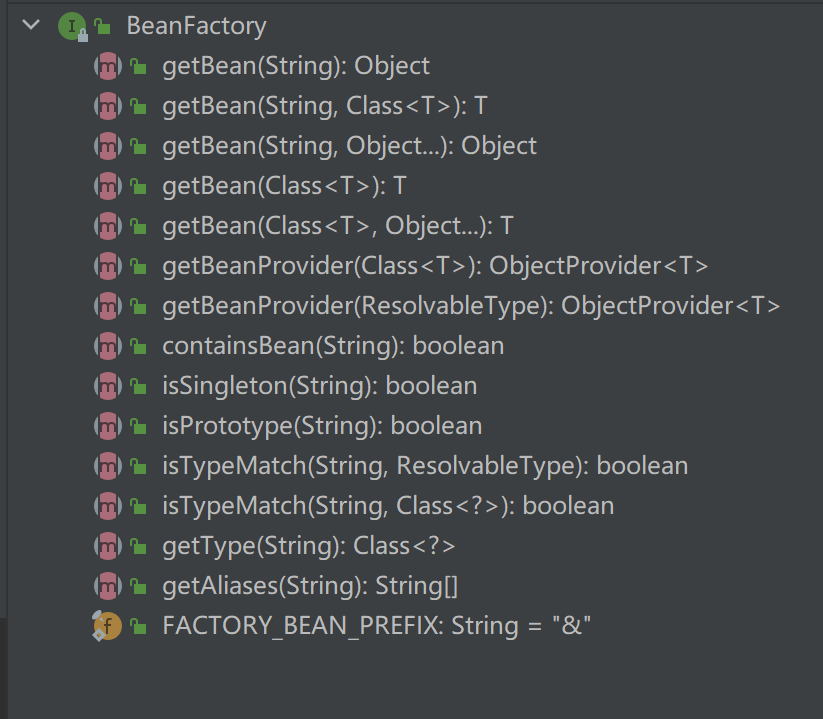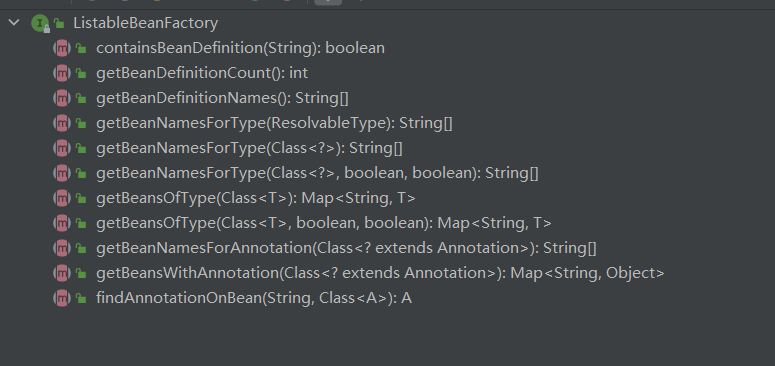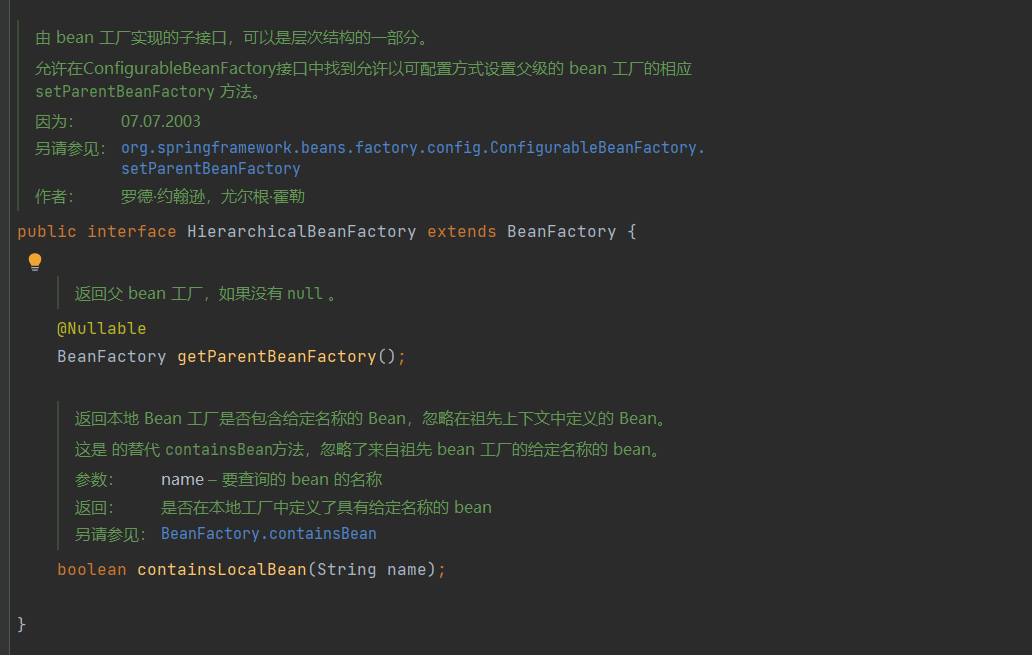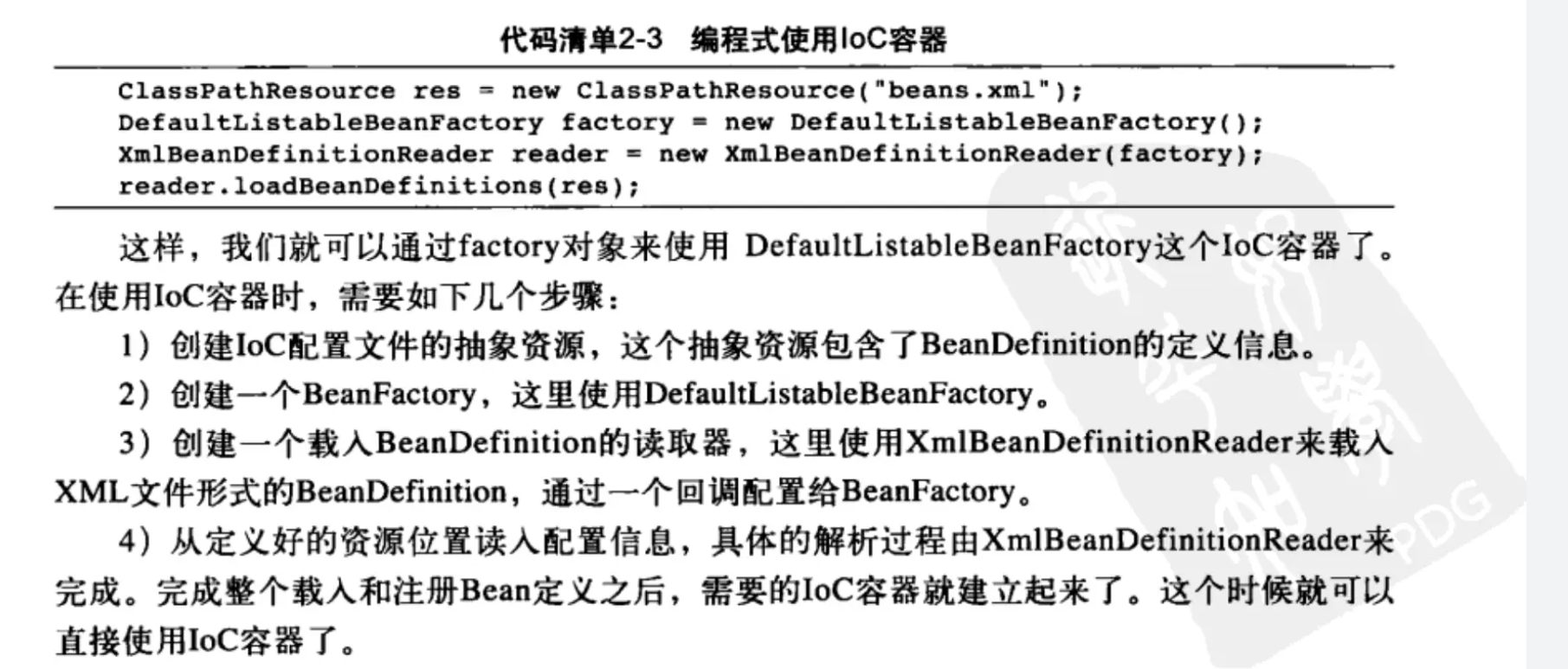Spring的核心是模組是Spring-IOC容器模組、Spring-AOP模組。
IOC容器
IOC容器的實現
容器分為兩大系列,一類是BeanFactory介面,另一類是ApplicationContext。BeanFactory
提供對單個bean的查詢等方法。Beanfacory介面定義了IOC容器的最基本形式。
ApplicationContext
ApplicationContext在BeanFacroty的基礎上,新增了其他高階特性。ApplicationContext一方面透過繼承ListableBeanFactory、HierarchicalBeanFactory,來獲取BeanFactory的功能;另一方面,透過繼承EnvironmentCapable、MessageSource、ApplicationEventPublisher、ResourcePatternResolver介面,來新增其他高階特性。public interface ApplicationContext extends
EnvironmentCapable, ListableBeanFactory, HierarchicalBeanFactory,
MessageSource, ApplicationEventPublisher, ResourcePatternResolver {
}
以下介紹ListableBeanFactory、HierarchicalBeanFactory的功能:
1、ListableBeanFactory:簡單來說,BeanFactory提供的是單個查詢Bean的方法,ListableBeanFactory在此基礎上,新增了批次查詢Bean的方法。

2、HierarchicalBeanFactory:對父類BeanFactory進行一些操作

3、MessageSource:國際化支援
4、ApplicationEventPublisher:事件釋出與監聽
IOC容器的設計
BeanFactory的功能
以XmlBeanFactory來分析,XmlBeanFactory繼承了DefaullistableBeanfactory。在Spring中,實標上是把DefaullistableBeanfactory作為一個預設的功能完整的loc容器來使用的。Xmlbeanfactory在繼承了Defaullistablebeanfactory容器的功能的同時,增加了新的功能,這些功能很容易從xmlbeanfactory的名字上猜到。它是一個與xml相關的BeanFactory,也就是說它是一個可以讀取以xml檔案方式定義的BeanDefinition的loc容器。
package org.springframework.beans.factory.xml;
import org.springframework.beans.BeansException;
import org.springframework.beans.factory.BeanFactory;
import org.springframework.beans.factory.support.DefaultListableBeanFactory;
import org.springframework.core.io.Resource;
@Deprecated
@SuppressWarnings({"serial", "all"})
public class XmlBeanFactory extends DefaultListableBeanFactory {
private final XmlBeanDefinitionReader reader = new XmlBeanDefinitionReader(this);
/**
* Create a new XmlBeanFactory with the given resource,
* which must be parsable using DOM.
* @param resource the XML resource to load bean definitions from
* @throws BeansException in case of loading or parsing errors
*/
public XmlBeanFactory(Resource resource) throws BeansException {
this(resource, null);
}
/**
* Create a new XmlBeanFactory with the given input stream,
* which must be parsable using DOM.
* @param resource the XML resource to load bean definitions from
* @param parentBeanFactory parent bean factory
* @throws BeansException in case of loading or parsing errors
*/
public XmlBeanFactory(Resource resource, BeanFactory parentBeanFactory) throws BeansException {
super(parentBeanFactory);
this.reader.loadBeanDefinitions(resource);
}
}
public class DefaultListableBeanFactory extends AbstractAutowireCapableBeanFactory
implements ConfigurableListableBeanFactory, BeanDefinitionRegistry, Serializable {
}
AbstractAutowireCapableBeanFactory:提供自動裝配
ConfigurableListableBeanFactory:bean生命週期的配置
DefaultListableBeanFactory:<font style="color:rgb(5, 7, 59);">DefaultListableBeanFactory</font>除了支援按型別和按名稱查詢bean外,還支援bean的註冊、自動裝配、屬性填充、生命週期管理等高階功能。而<font style="color:rgb(5, 7, 59);">ListableBeanFactory</font>主要聚焦於bean的查詢功能。
BeanFactory的設計原理
以XmlBeanfactory為例,如下:
ApplicationContext的功能
```java public interface ApplicationContext extends EnvironmentCapable, ListableBeanFactory, HierarchicalBeanFactory, MessageSource, ApplicationEventPublisher, ResourcePatternResolver {}
+ 支援不同的資訊源:我們看到Applicationcontext擴充套件了Messagesource介面,這些資訊源的擴充套件功能可以支援國際化的實現。
+ 訪問資源:這一特性體現在對ResourceLoader和Resource的支援上,這樣我們可以從不同地方得到bean定義資源。ResourcePatternResolver繼承了ResourceLoader介面
+ 支援應用事件:繼承了介面ApplicationEventPublisher,從而在上下文中引人了事件機制。這些事件和bean的生命週期的結合為bean的管理提供了便利。
ApplicationContext是一種面向框架的使用風格
<h3 id="LN7bI">ApplicationContext的設計原理</h3>
以FileSystemXmlApplicationContext為例,包含兩部分內容,一是refresh()介面來初始化容器,即啟動容器,這是所有ApplicationContext基本通用的部分。二是載入XML形式的bean定義檔案相關的部分。
<h1 id="cKuBA">容器的初始化過程</h1>
容器的初始化步驟分為:BeanDefinition的resource定位、BeanDefinition的載入和解析、BeanDefinition在IOC容器中的註冊;
<h2 id="zVL1U">DefaultListableBeanFactory的容器初始化</h2>
當我們使用DefaultListableBeanFactory作為容器時,啟動容器的過程如下:
```java
public class A {
// 假設A有一個簡單的方法
public void doSomething() {
System.out.println("A is doing something!");
}
}
public class B {
private A a;
// 構造器注入A
public B(A a) {
this.a = a;
}
// 或者使用setter方法注入A
// public void setA(A a) {
// this.a = a;
// }
public void doSomethingWithA() {
a.doSomething();
System.out.println("B is doing something with A!");
}
}
<?xml version="1.0" encoding="UTF-8"?>
<beans xmlns="http://www.springframework.org/schema/beans"
xmlns:xsi="http://www.w3.org/2001/XMLSchema-instance"
xsi:schemaLocation="http://www.springframework.org/schema/beans
http://www.springframework.org/schema/beans/spring-beans.xsd">
<!-- 定義A的bean -->
<bean id="aBean" class="cc.com.context.init.A" />
<!-- 定義B的bean,透過構造器注入A -->
<bean id="bBean" class="cc.com.context.init.B">
<constructor-arg ref="aBean" />
</bean>
</beans>
public class DefaultContextTest {
public static void main(String[] args) {
// beanDefinition資源定位
ClassPathResource classPathResource = new ClassPathResource("beans/beanDefinition.xml");
// 建立context
DefaultListableBeanFactory beanFactory = new DefaultListableBeanFactory();
// 建立Reader: beanDefinition的解析載入、beanDefinition在ioc容器中的註冊
XmlBeanDefinitionReader beanDefinitionReader = new XmlBeanDefinitionReader(beanFactory);
beanDefinitionReader.loadBeanDefinitions(classPathResource);
B b = beanFactory.getBean(B.class);
b.doSomethingWithA();
}
}
FileSystemXmlApplicationContext容器初始化
DefaultListableBeanFactory是BeanFactory這個型別的容器,如果將其換位ApplicationContext型別的容器FileSystemXmlApplicationContext,則容器的啟動過程如下(bean定義不變):public class ResourceTest {
public static void main(String[] args) {
String resourcePath = "beans\\beanDefinition.xml";
// 啟動容器
FileSystemXmlApplicationContext context = new FileSystemXmlApplicationContext(resourcePath);
B b = (B) context.getBean("bBean");
b.doSomethingWithA();
context.close();
}
}
與DefaultListableBeanFactory相比較,FileSystemXmlApplicationContext的啟動程式碼中少了beanDefinition資源定位、beanDefinition的解析載入相關程式碼。這部分程式碼在**refresh()**方法中。呼叫過程如下:
public class FileSystemXmlApplicationContext extends AbstractXmlApplicationContext {
// 類:FileSystemXmlApplicationContext;
// 初始化容器
public FileSystemXmlApplicationContext(String configLocation) throws BeansException {
this(new String[] {configLocation}, true, null);
}
public FileSystemXmlApplicationContext(
String[] configLocations, boolean refresh, @Nullable ApplicationContext parent)
throws BeansException {
super(parent);
setConfigLocations(configLocations);
if (refresh) {
// 容器初始化
refresh();
}
}
@Override
protected Resource getResourceByPath(String path) {
if (path.startsWith("/")) {
path = path.substring(1);
}
return new FileSystemResource(path);
}
}
public abstract class AbstractApplicationContext extends DefaultResourceLoader
implements ConfigurableApplicationContext {
//方法內部其他程式碼省略
@Override
public void refresh() throws BeansException, IllegalStateException {
synchronized (this.startupShutdownMonitor) {
ConfigurableListableBeanFactory beanFactory = obtainFreshBeanFactory();
}
protected ConfigurableListableBeanFactory obtainFreshBeanFactory() {
refreshBeanFactory();
return getBeanFactory();
}
}
public abstract class AbstractRefreshableApplicationContext extends AbstractApplicationContext {
@Override
protected final void refreshBeanFactory() throws BeansException {
if (hasBeanFactory()) {
destroyBeans();
closeBeanFactory();
}
try {
DefaultListableBeanFactory beanFactory = createBeanFactory();
beanFactory.setSerializationId(getId());
customizeBeanFactory(beanFactory);
// 定位beanDefinition資源、載入解析;
loadBeanDefinitions(beanFactory);
synchronized (this.beanFactoryMonitor) {
this.beanFactory = beanFactory;
}
}
catch (IOException ex) {
throw new ApplicationContextException("I/O error parsing bean definition source for " + getDisplayName(), ex);
}
}
}
public abstract class AbstractXmlApplicationContext extends AbstractRefreshableConfigApplicationContext {
@Override
protected void loadBeanDefinitions(DefaultListableBeanFactory beanFactory) throws BeansException, IOException {
// 建立讀取xml格式的beanDefinition的Reader類
XmlBeanDefinitionReader beanDefinitionReader = new XmlBeanDefinitionReader(beanFactory);
beanDefinitionReader.setEnvironment(this.getEnvironment());
beanDefinitionReader.setResourceLoader(this);
beanDefinitionReader.setEntityResolver(new ResourceEntityResolver(this));
initBeanDefinitionReader(beanDefinitionReader);
// beanDefinition資源的載入解析
loadBeanDefinitions(beanDefinitionReader);
}
protected void loadBeanDefinitions(XmlBeanDefinitionReader reader) throws BeansException, IOException {
Resource[] configResources = getConfigResources();
if (configResources != null) {
reader.loadBeanDefinitions(configResources);
}
String[] configLocations = getConfigLocations();
if (configLocations != null) {
reader.loadBeanDefinitions(configLocations);
}
}
}
Reader的建立,和對beanDefinition資源的讀取過程,全部在refresh()方法中,伴隨者容器的建立,自動執行。
bean例項的建立過程
原始碼分析
當bean設定為懶載入時,在容器初始化之後,beanFactory.getBean()方法被呼叫時,才會開始建立bean示例。當bean設定為懶載入時,在refresh()介面中,就會呼叫beanFactory.getBean()方法,來建立bean示例,這種情況在最後說明。bean例項的建立過程大體分為三步:初始化、依賴注入、示例化。以上一小節的單例bean定義A、B為例,分析bBean的建立過程。具體的建立流程在doGetBean方法中。
doGetBean:318, AbstractBeanFactory (org.springframework.beans.factory.support)
getBean:199, AbstractBeanFactory (org.springframework.beans.factory.support)
getBean:1105, AbstractApplicationContext (org.springframework.context.support)
main:11, ResourceTest (cc.com.context.init)
/**
* Return an instance, which may be shared or independent, of the specified bean.
* @param name the name of the bean to retrieve
* @param requiredType the required type of the bean to retrieve
* @param args arguments to use when creating a bean instance using explicit arguments
* (only applied when creating a new instance as opposed to retrieving an existing one)
* @param typeCheckOnly whether the instance is obtained for a type check,
* not for actual use
* @return an instance of the bean
* @throws BeansException if the bean could not be created
*/
@SuppressWarnings("unchecked")
protected <T> T doGetBean(final String name, @Nullable final Class<T> requiredType,
@Nullable final Object[] args, boolean typeCheckOnly) throws BeansException {
final String beanName = transformedBeanName(name);
Object bean;
// 先嚐試從快取中獲取bean例項,getSingleton的程式碼在下方
Object sharedInstance = getSingleton(beanName);
if (sharedInstance != null && args == null) {
if (logger.isTraceEnabled()) {
if (isSingletonCurrentlyInCreation(beanName)) {
logger.trace("Returning eagerly cached instance of singleton bean '" + beanName +
"' that is not fully initialized yet - a consequence of a circular reference");
}
else {
logger.trace("Returning cached instance of singleton bean '" + beanName + "'");
}
}
// 獲取bean的代理類
bean = getObjectForBeanInstance(sharedInstance, name, beanName, null);
}
else {
// Fail if we're already creating this bean instance:
// We're assumably within a circular reference.
if (isPrototypeCurrentlyInCreation(beanName)) {
throw new BeanCurrentlyInCreationException(beanName);
}
// Check if bean definition exists in this factory.
BeanFactory parentBeanFactory = getParentBeanFactory();
if (parentBeanFactory != null && !containsBeanDefinition(beanName)) {
// Not found -> check parent.
String nameToLookup = originalBeanName(name);
if (parentBeanFactory instanceof AbstractBeanFactory) {
return ((AbstractBeanFactory) parentBeanFactory).doGetBean(
nameToLookup, requiredType, args, typeCheckOnly);
}
else if (args != null) {
// Delegation to parent with explicit args.
return (T) parentBeanFactory.getBean(nameToLookup, args);
}
else if (requiredType != null) {
// No args -> delegate to standard getBean method.
return parentBeanFactory.getBean(nameToLookup, requiredType);
}
else {
return (T) parentBeanFactory.getBean(nameToLookup);
}
}
if (!typeCheckOnly) {
markBeanAsCreated(beanName);
}
try {
final RootBeanDefinition mbd = getMergedLocalBeanDefinition(beanName);
checkMergedBeanDefinition(mbd, beanName, args);
// Guarantee initialization of beans that the current bean depends on.
String[] dependsOn = mbd.getDependsOn();
if (dependsOn != null) {
for (String dep : dependsOn) {
if (isDependent(beanName, dep)) {
throw new BeanCreationException(mbd.getResourceDescription(), beanName,
"Circular depends-on relationship between '" + beanName + "' and '" + dep + "'");
}
registerDependentBean(dep, beanName);
try {
getBean(dep);
}
catch (NoSuchBeanDefinitionException ex) {
throw new BeanCreationException(mbd.getResourceDescription(), beanName,
"'" + beanName + "' depends on missing bean '" + dep + "'", ex);
}
}
}
// Create bean instance.
if (mbd.isSingleton()) {
// 如果從快取中獲取不到bean,則呼叫getSingleton方法,
// 在入參中傳入一個singltonFactory物件(重寫了getObject方法)
// 注:singltonFactory是一個獲取單例bean的工廠類
sharedInstance = getSingleton(beanName, () -> {
try {
return createBean(beanName, mbd, args);
}
catch (BeansException ex) {
// Explicitly remove instance from singleton cache: It might have been put there
// eagerly by the creation process, to allow for circular reference resolution.
// Also remove any beans that received a temporary reference to the bean.
destroySingleton(beanName);
throw ex;
}
});
bean = getObjectForBeanInstance(sharedInstance, name, beanName, mbd);
}
else if (mbd.isPrototype()) {
// It's a prototype -> create a new instance.
Object prototypeInstance = null;
try {
beforePrototypeCreation(beanName);
prototypeInstance = createBean(beanName, mbd, args);
}
finally {
afterPrototypeCreation(beanName);
}
bean = getObjectForBeanInstance(prototypeInstance, name, beanName, mbd);
}
else {
String scopeName = mbd.getScope();
final Scope scope = this.scopes.get(scopeName);
if (scope == null) {
throw new IllegalStateException("No Scope registered for scope name '" + scopeName + "'");
}
try {
Object scopedInstance = scope.get(beanName, () -> {
beforePrototypeCreation(beanName);
try {
return createBean(beanName, mbd, args);
}
finally {
afterPrototypeCreation(beanName);
}
});
bean = getObjectForBeanInstance(scopedInstance, name, beanName, mbd);
}
catch (IllegalStateException ex) {
throw new BeanCreationException(beanName,
"Scope '" + scopeName + "' is not active for the current thread; consider " +
"defining a scoped proxy for this bean if you intend to refer to it from a singleton",
ex);
}
}
}
catch (BeansException ex) {
cleanupAfterBeanCreationFailure(beanName);
throw ex;
}
}
// Check if required type matches the type of the actual bean instance.
if (requiredType != null && !requiredType.isInstance(bean)) {
try {
T convertedBean = getTypeConverter().convertIfNecessary(bean, requiredType);
if (convertedBean == null) {
throw new BeanNotOfRequiredTypeException(name, requiredType, bean.getClass());
}
return convertedBean;
}
catch (TypeMismatchException ex) {
if (logger.isTraceEnabled()) {
logger.trace("Failed to convert bean '" + name + "' to required type '" +
ClassUtils.getQualifiedName(requiredType) + "'", ex);
}
throw new BeanNotOfRequiredTypeException(name, requiredType, bean.getClass());
}
}
return (T) bean;
}
以下是getSingleton方法的原始碼
@Override
@Nullable
public Object getSingleton(String beanName) {
return getSingleton(beanName, true);
}
@Nullable
protected Object getSingleton(String beanName, boolean allowEarlyReference) {
// 如果一級快取中存在,則從一級快取中取
Object singletonObject = this.singletonObjects.get(beanName);
if (singletonObject == null && isSingletonCurrentlyInCreation(beanName)) {
synchronized (this.singletonObjects) {
// 如果二級快取中存在, 則從二級快取中取
singletonObject = this.earlySingletonObjects.get(beanName);
if (singletonObject == null && allowEarlyReference) {
// 如果一級、二級中均不存在,則從三級快取中取出singletonFactory,來初始化bean
ObjectFactory<?> singletonFactory = this.singletonFactories.get(beanName);
if (singletonFactory != null) {
// 獲取單例bean,將其放入二級快取,並刪除三級快取的內容
singletonObject = singletonFactory.getObject();
this.earlySingletonObjects.put(beanName, singletonObject);
this.singletonFactories.remove(beanName);
}
}
}
}
return singletonObject;
}
public Object getSingleton(String beanName, ObjectFactory<?> singletonFactory) {
Assert.notNull(beanName, "Bean name must not be null");
synchronized (this.singletonObjects) {
// 先從一級快取中取,若取不到,則從singletonFactory方法中取
Object singletonObject = this.singletonObjects.get(beanName);
if (singletonObject == null) {
if (this.singletonsCurrentlyInDestruction) {
throw new BeanCreationNotAllowedException(beanName,
"Singleton bean creation not allowed while singletons of this factory are in destruction " +
"(Do not request a bean from a BeanFactory in a destroy method implementation!)");
}
if (logger.isDebugEnabled()) {
logger.debug("Creating shared instance of singleton bean '" + beanName + "'");
}
beforeSingletonCreation(beanName);
boolean newSingleton = false;
boolean recordSuppressedExceptions = (this.suppressedExceptions == null);
if (recordSuppressedExceptions) {
this.suppressedExceptions = new LinkedHashSet<>();
}
try {
// 獲取bean, 其中getObject方法的具體實現就是createBean方法
singletonObject = singletonFactory.getObject();
newSingleton = true;
}
catch (IllegalStateException ex) {
// Has the singleton object implicitly appeared in the meantime ->
// if yes, proceed with it since the exception indicates that state.
singletonObject = this.singletonObjects.get(beanName);
if (singletonObject == null) {
throw ex;
}
}
catch (BeanCreationException ex) {
if (recordSuppressedExceptions) {
for (Exception suppressedException : this.suppressedExceptions) {
ex.addRelatedCause(suppressedException);
}
}
throw ex;
}
finally {
if (recordSuppressedExceptions) {
this.suppressedExceptions = null;
}
afterSingletonCreation(beanName);
}
// 如果是初次初始化的單例,則放入一級快取,並移除二、三級快取的內容
if (newSingleton) {
addSingleton(beanName, singletonObject);
}
}
return singletonObject;
}
}
以下是createBean方法的原始碼
/**
* Central method of this class: creates a bean instance,
* populates the bean instance, applies post-processors, etc.
* @see #doCreateBean
*/
@Override
protected Object createBean(String beanName, RootBeanDefinition mbd, @Nullable Object[] args)
throws BeanCreationException {
if (logger.isTraceEnabled()) {
logger.trace("Creating instance of bean '" + beanName + "'");
}
RootBeanDefinition mbdToUse = mbd;
// Make sure bean class is actually resolved at this point, and
// clone the bean definition in case of a dynamically resolved Class
// which cannot be stored in the shared merged bean definition.
Class<?> resolvedClass = resolveBeanClass(mbd, beanName);
if (resolvedClass != null && !mbd.hasBeanClass() && mbd.getBeanClassName() != null) {
mbdToUse = new RootBeanDefinition(mbd);
mbdToUse.setBeanClass(resolvedClass);
}
// Prepare method overrides.
try {
mbdToUse.prepareMethodOverrides();
}
catch (BeanDefinitionValidationException ex) {
throw new BeanDefinitionStoreException(mbdToUse.getResourceDescription(),
beanName, "Validation of method overrides failed", ex);
}
try {
// Give BeanPostProcessors a chance to return a proxy instead of the target bean instance.
Object bean = resolveBeforeInstantiation(beanName, mbdToUse);
if (bean != null) {
return bean;
}
}
catch (Throwable ex) {
throw new BeanCreationException(mbdToUse.getResourceDescription(), beanName,
"BeanPostProcessor before instantiation of bean failed", ex);
}
try {
// 例項化bean的具體建立過程在doCreateBean方法中
Object beanInstance = doCreateBean(beanName, mbdToUse, args);
if (logger.isTraceEnabled()) {
logger.trace("Finished creating instance of bean '" + beanName + "'");
}
return beanInstance;
}
catch (BeanCreationException | ImplicitlyAppearedSingletonException ex) {
// A previously detected exception with proper bean creation context already,
// or illegal singleton state to be communicated up to DefaultSingletonBeanRegistry.
throw ex;
}
catch (Throwable ex) {
throw new BeanCreationException(
mbdToUse.getResourceDescription(), beanName, "Unexpected exception during bean creation", ex);
}
}
/**
* Actually create the specified bean. Pre-creation processing has already happened
* at this point, e.g. checking {@code postProcessBeforeInstantiation} callbacks.
* <p>Differentiates between default bean instantiation, use of a
* factory method, and autowiring a constructor.
* @param beanName the name of the bean
* @param mbd the merged bean definition for the bean
* @param args explicit arguments to use for constructor or factory method invocation
* @return a new instance of the bean
* @throws BeanCreationException if the bean could not be created
* @see #instantiateBean
* @see #instantiateUsingFactoryMethod
* @see #autowireConstructor
*/
protected Object doCreateBean(final String beanName, final RootBeanDefinition mbd, final @Nullable Object[] args)
throws BeanCreationException {
// 例項化bean
BeanWrapper instanceWrapper = null;
if (mbd.isSingleton()) {
instanceWrapper = this.factoryBeanInstanceCache.remove(beanName);
}
if (instanceWrapper == null) {
instanceWrapper = createBeanInstance(beanName, mbd, args);
}
final Object bean = instanceWrapper.getWrappedInstance();
Class<?> beanType = instanceWrapper.getWrappedClass();
if (beanType != NullBean.class) {
mbd.resolvedTargetType = beanType;
}
// Allow post-processors to modify the merged bean definition.
synchronized (mbd.postProcessingLock) {
if (!mbd.postProcessed) {
try {
applyMergedBeanDefinitionPostProcessors(mbd, beanType, beanName);
}
catch (Throwable ex) {
throw new BeanCreationException(mbd.getResourceDescription(), beanName,
"Post-processing of merged bean definition failed", ex);
}
mbd.postProcessed = true;
}
}
// Eagerly cache singletons to be able to resolve circular references
// even when triggered by lifecycle interfaces like BeanFactoryAware.
boolean earlySingletonExposure = (mbd.isSingleton() && this.allowCircularReferences &&
isSingletonCurrentlyInCreation(beanName));
if (earlySingletonExposure) {
if (logger.isTraceEnabled()) {
logger.trace("Eagerly caching bean '" + beanName +
"' to allow for resolving potential circular references");
}
// 將singletonFactory放入三級快取
addSingletonFactory(beanName, () -> getEarlyBeanReference(beanName, mbd, bean));
}
// 將初始化的bean例項化
Object exposedObject = bean;
try {
// 依賴注入
populateBean(beanName, mbd, instanceWrapper);
// 初始化
exposedObject = initializeBean(beanName, exposedObject, mbd);
}
catch (Throwable ex) {
if (ex instanceof BeanCreationException && beanName.equals(((BeanCreationException) ex).getBeanName())) {
throw (BeanCreationException) ex;
}
else {
throw new BeanCreationException(
mbd.getResourceDescription(), beanName, "Initialization of bean failed", ex);
}
}
if (earlySingletonExposure) {
Object earlySingletonReference = getSingleton(beanName, false);
if (earlySingletonReference != null) {
if (exposedObject == bean) {
exposedObject = earlySingletonReference;
}
else if (!this.allowRawInjectionDespiteWrapping && hasDependentBean(beanName)) {
String[] dependentBeans = getDependentBeans(beanName);
Set<String> actualDependentBeans = new LinkedHashSet<>(dependentBeans.length);
for (String dependentBean : dependentBeans) {
if (!removeSingletonIfCreatedForTypeCheckOnly(dependentBean)) {
actualDependentBeans.add(dependentBean);
}
}
if (!actualDependentBeans.isEmpty()) {
throw new BeanCurrentlyInCreationException(beanName,
"Bean with name '" + beanName + "' has been injected into other beans [" +
StringUtils.collectionToCommaDelimitedString(actualDependentBeans) +
"] in its raw version as part of a circular reference, but has eventually been " +
"wrapped. This means that said other beans do not use the final version of the " +
"bean. This is often the result of over-eager type matching - consider using " +
"'getBeanNamesOfType' with the 'allowEagerInit' flag turned off, for example.");
}
}
}
}
// Register bean as disposable.
try {
registerDisposableBeanIfNecessary(beanName, bean, mbd);
}
catch (BeanDefinitionValidationException ex) {
throw new BeanCreationException(
mbd.getResourceDescription(), beanName, "Invalid destruction signature", ex);
}
return exposedObject;
}
/**
* Add the given singleton factory for building the specified singleton
* if necessary.
* <p>To be called for eager registration of singletons, e.g. to be able to
* resolve circular references.
* @param beanName the name of the bean
* @param singletonFactory the factory for the singleton object
*/
protected void addSingletonFactory(String beanName, ObjectFactory<?> singletonFactory) {
Assert.notNull(singletonFactory, "Singleton factory must not be null");
synchronized (this.singletonObjects) {
if (!this.singletonObjects.containsKey(beanName)) {
this.singletonFactories.put(beanName, singletonFactory);
this.earlySingletonObjects.remove(beanName);
this.registeredSingletons.add(beanName);
}
}
}
下面是依賴注入的方法populateBean()
/**
* Populate the bean instance in the given BeanWrapper with the property values
* from the bean definition.
* @param beanName the name of the bean
* @param mbd the bean definition for the bean
* @param bw the BeanWrapper with bean instance
*/
@SuppressWarnings("deprecation") // for postProcessPropertyValues
protected void populateBean(String beanName, RootBeanDefinition mbd, @Nullable BeanWrapper bw) {
if (bw == null) {
if (mbd.hasPropertyValues()) {
throw new BeanCreationException(
mbd.getResourceDescription(), beanName, "Cannot apply property values to null instance");
}
else {
// Skip property population phase for null instance.
return;
}
}
// Give any InstantiationAwareBeanPostProcessors the opportunity to modify the
// state of the bean before properties are set. This can be used, for example,
// to support styles of field injection.
boolean continueWithPropertyPopulation = true;
if (!mbd.isSynthetic() && hasInstantiationAwareBeanPostProcessors()) {
for (BeanPostProcessor bp : getBeanPostProcessors()) {
if (bp instanceof InstantiationAwareBeanPostProcessor) {
InstantiationAwareBeanPostProcessor ibp = (InstantiationAwareBeanPostProcessor) bp;
if (!ibp.postProcessAfterInstantiation(bw.getWrappedInstance(), beanName)) {
continueWithPropertyPopulation = false;
break;
}
}
}
}
if (!continueWithPropertyPopulation) {
return;
}
PropertyValues pvs = (mbd.hasPropertyValues() ? mbd.getPropertyValues() : null);
// 根據名稱或這型別來執行依賴注入
if (mbd.getResolvedAutowireMode() == AUTOWIRE_BY_NAME || mbd.getResolvedAutowireMode() == AUTOWIRE_BY_TYPE) {
MutablePropertyValues newPvs = new MutablePropertyValues(pvs);
// Add property values based on autowire by name if applicable.
if (mbd.getResolvedAutowireMode() == AUTOWIRE_BY_NAME) {
autowireByName(beanName, mbd, bw, newPvs);
}
// Add property values based on autowire by type if applicable.
if (mbd.getResolvedAutowireMode() == AUTOWIRE_BY_TYPE) {
autowireByType(beanName, mbd, bw, newPvs);
}
pvs = newPvs;
}
boolean hasInstAwareBpps = hasInstantiationAwareBeanPostProcessors();
boolean needsDepCheck = (mbd.getDependencyCheck() != AbstractBeanDefinition.DEPENDENCY_CHECK_NONE);
PropertyDescriptor[] filteredPds = null;
if (hasInstAwareBpps) {
if (pvs == null) {
pvs = mbd.getPropertyValues();
}
for (BeanPostProcessor bp : getBeanPostProcessors()) {
if (bp instanceof InstantiationAwareBeanPostProcessor) {
InstantiationAwareBeanPostProcessor ibp = (InstantiationAwareBeanPostProcessor) bp;
PropertyValues pvsToUse = ibp.postProcessProperties(pvs, bw.getWrappedInstance(), beanName);
if (pvsToUse == null) {
if (filteredPds == null) {
filteredPds = filterPropertyDescriptorsForDependencyCheck(bw, mbd.allowCaching);
}
pvsToUse = ibp.postProcessPropertyValues(pvs, filteredPds, bw.getWrappedInstance(), beanName);
if (pvsToUse == null) {
return;
}
}
pvs = pvsToUse;
}
}
}
if (needsDepCheck) {
if (filteredPds == null) {
filteredPds = filterPropertyDescriptorsForDependencyCheck(bw, mbd.allowCaching);
}
checkDependencies(beanName, mbd, filteredPds, pvs);
}
if (pvs != null) {
applyPropertyValues(beanName, mbd, bw, pvs);
}
}
/**
* Fill in any missing property values with references to
* other beans in this factory if autowire is set to "byName".
* @param beanName the name of the bean we're wiring up.
* Useful for debugging messages; not used functionally.
* @param mbd bean definition to update through autowiring
* @param bw the BeanWrapper from which we can obtain information about the bean
* @param pvs the PropertyValues to register wired objects with
*/
protected void autowireByName(
String beanName, AbstractBeanDefinition mbd, BeanWrapper bw, MutablePropertyValues pvs) {
String[] propertyNames = unsatisfiedNonSimpleProperties(mbd, bw);
for (String propertyName : propertyNames) {
if (containsBean(propertyName)) {
// 此處又呼叫getBean(),來獲取依賴的bean
Object bean = getBean(propertyName);
pvs.add(propertyName, bean);
registerDependentBean(propertyName, beanName);
if (logger.isTraceEnabled()) {
logger.trace("Added autowiring by name from bean name '" + beanName +
"' via property '" + propertyName + "' to bean named '" + propertyName + "'");
}
}
else {
if (logger.isTraceEnabled()) {
logger.trace("Not autowiring property '" + propertyName + "' of bean '" + beanName +
"' by name: no matching bean found");
}
}
}
}
bean建立流程總結
以下是主要流程(doGetBean、createBean)的虛擬碼public class Test {
public Object getBean(String name) throws BeansException {
doGetBean(引數...);
}
protected <T> T doGetBean(final String name, @Nullable final Class<T> requiredType,
@Nullable final Object[] args, boolean typeCheckOnly) throws BeansException{
bean = getSingleton(beanName, false);
if (bean == null) {
ObjectFactory beanFactory = () -> {
return createBean(beanName, mbd, args);
};
bean = getSingleton(beanName, beanFactory);
}
}
protected Object getSingleton(String beanName, boolean allowEarlyReference) {
if(singletonObjects快取存在bean) return bean;
if(earySingletonObjects快取存在bean) return bean;
if(singletonFactories快取存在singletonFactory != null) {
singletonFactory = singletonFactories.getSingletonFactory;
bean = singletonFactory.getObject(呼叫createBean());
bean快取至earySingletonObjects;
刪除在singletonFactories中的快取;
}
}
public Object getSingleton(String beanName, ObjectFactory<?> singletonFactory) {
if(singletonObjects快取存在bean) {
bean = singletonObjects.getBean(beanName);
} eles {
bean = singletonFactory.getObject(呼叫createBean());
}
if(初次生成的bean) {
bean快取至singletonObjects;
刪除在earySingletonObjects、singletonFactories中的快取;
}
}
protected Object createBean(String beanName, RootBeanDefinition mbd, @Nullable Object[] args)
throws BeanCreationException{
}
protected Object doCreateBean(final String beanName, final RootBeanDefinition mbd, final @Nullable Object[] args)
throws BeanCreationException {
bean = 例項化bean;
將singletonFactory快取至singletonFactories;
依賴注入,呼叫populateBean();
初始化bean;
return bean;
}
protected void populateBean(String beanName, RootBeanDefinition mbd, @Nullable BeanWrapper bw) {
選擇依賴注入的方式;
for() {
被依賴的bean = getBean(beanName);
}
完成依賴注入;
}
- **getBean( ) -> doGetBean( )**
* 呼叫**getSingleton(beanName)**方法:
+ 先在singletonObjects中查詢bean,若存在,則返回bean;
+ 若上一步取不到bean,在earySingletonObjects中查詢bean,若存在,則返回bean,並將其放入**earySingletonObjects**,並刪除singletonFactories。反之查詢singletonFactories;
+ 若上一步取不到bean,在singletonFactories中查詢bean對應的singletonFactory,若存在,則返回單例bean;
* 若上一步未查詢到bean,則生成一個singletonFactory(將getObject( )方法重寫為**createBean( )**方法),再呼叫getSingleton(beanName,singletonFactory)方法:
+ 先在singletonObjects中查詢bean,若存在,則返回bean;
+ 若上一步取不到bean,則呼叫singletonFactory的getObject中取(觸發createBean方法);
+ 得到初始化後的bean,將如果bean是首次生成的,則**快取至singletonObjects**,刪除其他快取;
* **createBean( ) -> doCreateBean( )** **:**
+ 例項化bean
+ 將singletonFactory快取至singletonFactories;
+ 依賴注入populateBean( ):
- 如果有依賴,則透過條用getBean( )介面來獲取依賴的beanB(這一步將beanB的singletonFactory快取至singletonFactories);
- 將beanB快取至earlySingletonFactory,刪除singletonFactories中的快取;
- 注入beanB;
+ 初始化:初始化bean;
+ 返回初始化後的bean;
三級快取
關於我們熟知的三級快取的,以下是bean放入三級快取的時刻: * singletonFactories快取:是在首次建立bean時,將singletonFactory存入singletonFactories,入口在**createBean( ) -> doCreateBean( )**
* earlySingletonObjects快取:是bean被注入其他bean後,將被注入的bean快取至earlySingletonObjects,入口在**populateBean( ) -> getBean( ) -> doGetBean( ) -> getSingleton(beanName)**
* singletonObjects快取:是在bean完成初始化之後,將bean快取至singletonObjects;入口在**getBean( ) -> doGetBean( )**